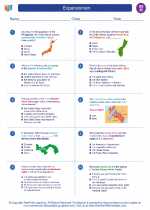Continents
Continents are large land masses on Earth's surface. There are seven continents: Africa, Antarctica, Asia, Europe, North America, Australia, and South America. Each continent has its own unique characteristics, including landforms, climate, and cultures.
Africa
Africa is the second largest continent and is known for its diverse wildlife, including the "Big Five" animals: lions, elephants, buffalo, leopards, and rhinoceroses. It is also home to the Sahara Desert, the largest hot desert in the world.
Antarctica
Antarctica is the southernmost continent and is covered in ice. It is the coldest, driest, and windiest continent, and is home to unique species such as penguins and seals.
Asia
Asia is the largest and most populous continent, known for its rich history and diverse cultures. It is home to the Himalayas, the highest mountain range in the world, and the Gobi Desert.
Europe
Europe is known for its rich history, art, and architecture. It is also home to the Alps, a major mountain range, and the Mediterranean Sea.
North America
North America is the third largest continent and is known for its diverse landscapes, including the Rocky Mountains, the Grand Canyon, and the Great Lakes. It is also home to the United States, Canada, and Mexico.
Australia
Australia is the smallest continent and is known for its unique wildlife, including kangaroos, koalas, and the Great Barrier Reef, the world's largest coral reef system.
South America
South America is known for its diverse ecosystems, including the Amazon Rainforest, the Andes Mountains, and the Galápagos Islands. It is also home to Machu Picchu, an ancient Incan city.
Study Guide
- What are the seven continents?
- Identify the unique characteristics of each continent.
- Locate major landforms and bodies of water on each continent.
- Compare and contrast the climates of different continents.
- Research and present on the cultures and traditions of one or more continents.
Understanding the continents is essential for understanding the diverse geography and cultures of our world. Studying the continents can also help us appreciate the interconnectedness of our planet and the importance of global cooperation and understanding.
[Continents] Related Worksheets and Study Guides:
.◂Social Studies Worksheets and Study Guides Eighth Grade. Expansionism

 Worksheet/Answer key
Worksheet/Answer key
 Worksheet/Answer key
Worksheet/Answer key
 Worksheet/Answer key
Worksheet/Answer key
 Worksheet/Answer key
Worksheet/Answer key
